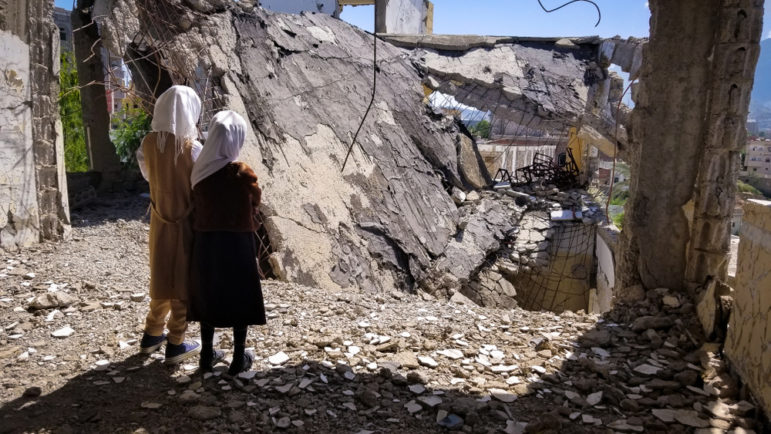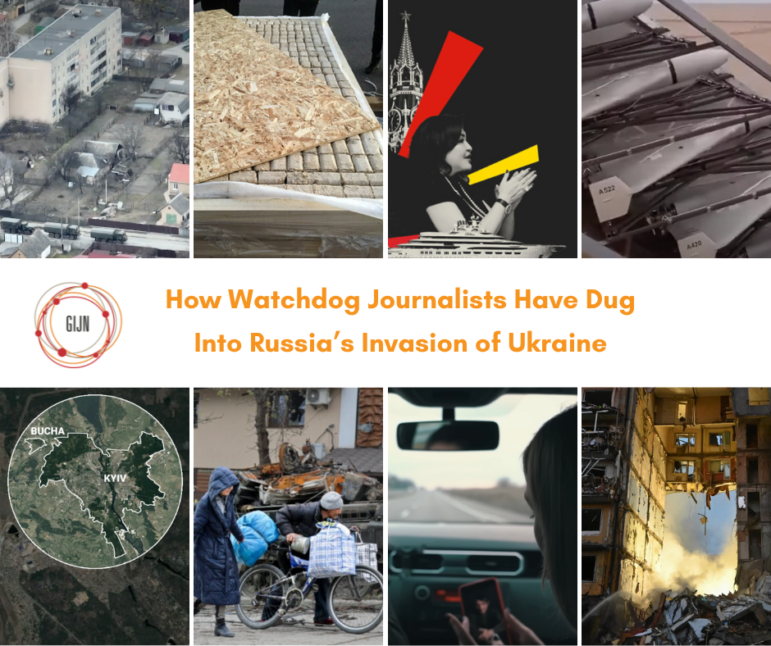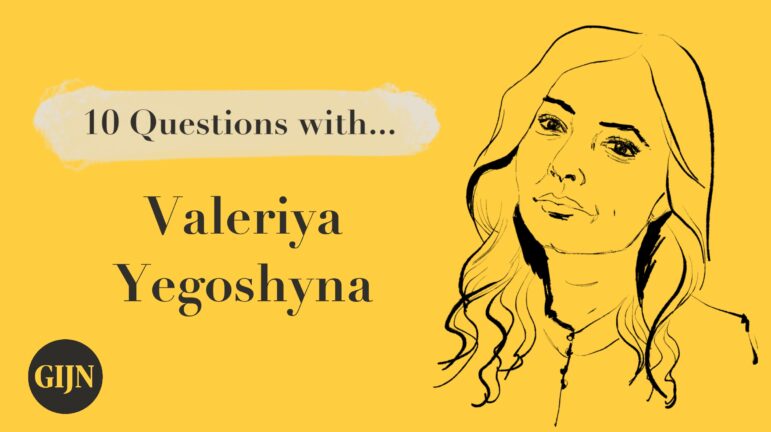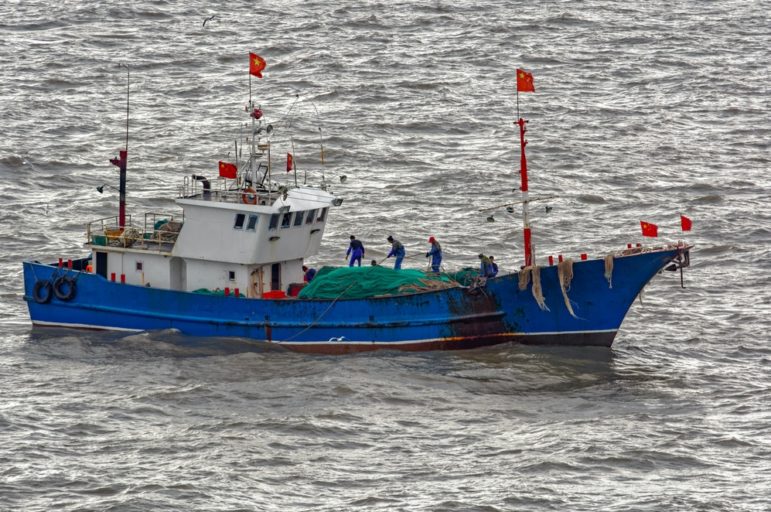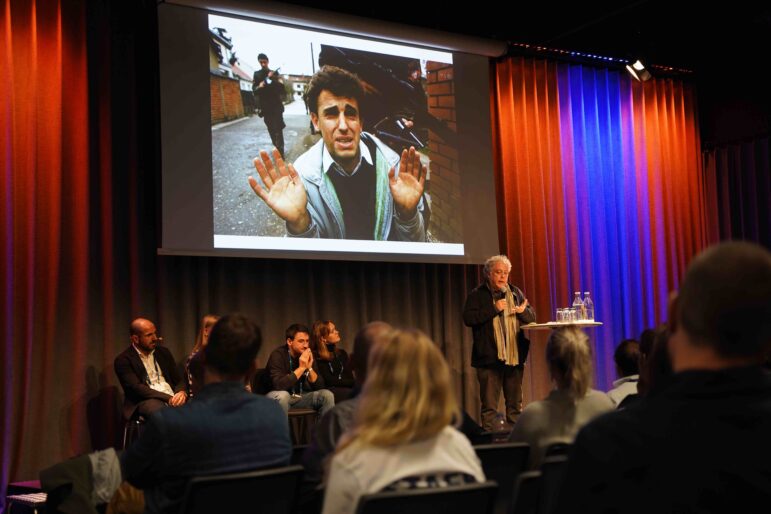

Award-winning photojournalist Ron Haviv speaks at the GIJC23 panel on investigating war crimes. Image: Edvin Lundqvist for GIJN
The Power of Documenting War Crimes — and How to Do It
From the current atrocities being uncovered in Ukraine to the trials of criminals from the Bosnian war, journalism’s work of investigating war crimes is essential in making accountability possible. The split-second decision to take the photograph of an off-handed act of cruelty may later become the documentary evidence to take war criminals to court. Finding a Russian soldier’s discarded smartphone amongst the rubble might lead to identifying who gave orders to deport Ukrainian children from a village.
The 13th Global Investigative Journalism Conference’s (#GIJC23) panel “Investigating War Crimes,” moderated by Denis Džidić, executive director and editor of the Balkan Investigative Reporting Network in Bosnia and Herzegovina (BIRN BiH), featured Yanina Korniienko, Ukrainian journalist from Slidstvo.Info — an anti-corruption journalism platform that pivoted to war crime reporting after the Russian invasion — Nick Waters, Bellingcat’s digital investigator for the Syria, Yemen, and Ukraine conflicts, Sophia Jones, award-winning journalist and current war crimes and human rights violations investigator for Human Rights Watch, and Ron Haviv. Haviv is one of the world’s leading photojournalists and founder of VII Foundation, whose photographs have been the basis for proving war crimes in the Serbian war, as described in his upcoming documentary, “Biography of a Photo.”
Haviv, Džidić, and Waters also contributed to GIJN’s Reporter’s Guide to Investigating War Crimes, released earlier this month, in which more than a dozen veteran journalists and experts wrote on topics such as what is legal in war, conflict-related sexual violence, genocide, forced disappearances, and banned and restricted weapons.
Being familiar with international humanitarian law, knowing what is legal or not, and what weapons are banned and restricted was knowledge that Bellingcat’s Nick Waters insisted was essential. “It’s very important to at least understand the basic principles when you are trying to establish if illegal atrocities are being committed,” he said. “Even under these laws, pretty horrible things can happen which are entirely legal.”
This knowledge allows journalists to detect crucial nuances. For example, phosphorus as an incendiary weapon is legal, but when its toxic fumes are used in tunnels to kill enemies, it is considered a chemical weapon and is illegal. Being familiar with weaponry — like if certain rockets are very precise or not, which units use what kinds of artillery, and at what angle do certain shells fall — will give you information that might lead to uncovering if a given commander gave an order that constituted a war crime. And the most important tip shared by Waters, never disturb anything you find in a war zone that an explosives ordnance team hasn’t confirmed is safe. Or, as he more bluntly put it: “Don’t pick up stuff.”
Identifying specific Russian soldiers and commanders that have committed war crimes is the daily beat of Korniienko and her team since the invasion of Ukraine. After a year and a half of conflict, they’ve developed a methodology to scour for clues when a Russian occupied city is liberated. The steps are:
- Do on-the-ground reporting in the liberated city as soon as possible.
- Collect and document evidence from the ground, including bullets, documents, photographs, videos, and other physical objects.
- Identify Russian soldiers and collaborators who may have committed war crimes. Social media profiles, databases, and open-source investigation can give very detailed information.
- Interview witnesses of war crimes, although make sure not to publish before you’re 100% certain all the sources interviewed are safe.
“We’re also doing this to show the world how the idea that this is Putin’s war, and all these soldiers don’t want to do this [is questionable]. When we open their social media, we see that they hated Ukraine for years,” said Korniienko. This would prove the war wasn’t a sudden decision and the Russian regime long fostered hatred towards Ukraine amongst the Russian population.
Jones also highlighted the importance of open source research, which she recommends combining with on-the-ground research, as Slidstvo.Info’s team does. She also suggested that reporters read the “Berkeley Protocol on Digital Open-Source Investigations” from cover to cover. Five essential tips Jones shared were:
- Understand the basics of open-source investigation.
- Familiarize yourself with new tools and technologies.
- Take breaks and prioritize your mental health.
- Document your findings and standardize workflow. Use spreadsheets to build archives.
- Prioritize archiving workflow to preserve evidence and maximize accountability.
A lot of the evidence collected will be visual. Photographs taken in the right place at the right time will be used in trials for war crimes, even if taken just after a crime is committed: “Even though the photograph is the aftermath of the war crime it still has power,” said Haviv, adding that this power also extends to how some photographs and images become part of the life and society of people in conflict zones, by preserving their memory, identity, and dignity.
Similar words may be said about all journalism that documents war crimes. Establishing the truth of what happened during war is, essentially, a society-building and conserving activity, because most war criminals ultimately intend to obliterate a way of life: a living, breathing culture.






